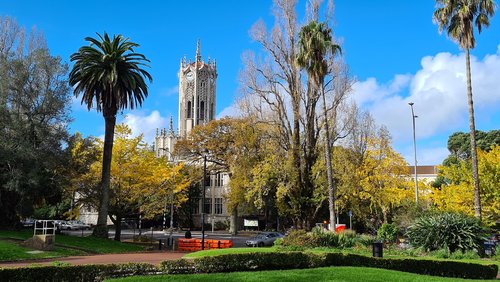20 Jul 2023
At the last count there were 4.4 million cars on New Zealand roads and the transport sector is responsible for 17 percent of Aotearoa’s gross emissions. But there are a number of projects underway in Aotearoa aimed at addressing climate change through varied mobility modes.
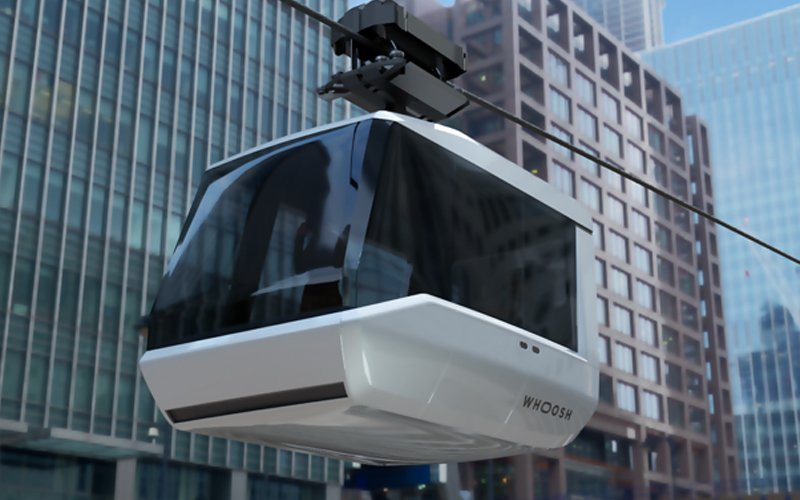
Photo: Holmes Solutions
Off road travel
One company seeking to shift passengers off our overcrowded roads is Holmes Solutions with its new technology, Whoosh. Its alternative point-to-point transport system is a cable-based system of autonomous electric vehicles that integrate with a rail track situated above traffic, difficult terrain and obstacles. The technology to move the vehicles along the combined guideway of cable or track exists within each vehicle, meaning there are no moving parts on the guideway. This allows the vehicles to change direction, switch tracks, and diverge to offline stations.
“The key to our technology is the rail-to-cable and cable-to-rail transition,” says Pete Scott, Technical Director at Holmes Solutions, who supplies the technology and know-how to Whoosh.
“Because the whole system is supported on the cable and the track is long, it means the vehicle can come in at high speeds and there is time for alignment to the cable. This, in turn, leads to a high-capacity network and great energy efficiencies.”
Pete says the embodied carbon in a Whoosh transportation system is 184T of CO2e/km, significantly lower than rail transportation on the ground, which accounts for 941 (+/-168) T of CO2e/km.
The technology is on the path to certification and will be piloted in Queenstown’s Remarkables Park in the next two years.

Photo: Wisk Aero LLC
Hailing a new era for taxis
Wisk is another business seeking to shape the future of mobility. It’s the developer of a self-flying, all-electric, four-seat electric vertical take-off and landing (eVTOL) air taxi. Its sixth-generation aircraft, currently under development, takes off and lands vertically, but flies like an aeroplane.
“This aircraft represents the first-ever candidate for Federal Aviation Administration certification of an autonomous, passenger-carrying eVTOL air taxi,” says Sam Nepia, Product Development and Mechanical Engineer, Energy Storage and Power System at Wisk.
“The thousands of batteries within this technology have enabled us to rethink the future of aerospace.”
The vertical landing negates the need for a runway. Hence highly urbanised areas will lend themselves to vertiports where charging and light maintenance will take place. By combining industry-leading autonomous technology and software, these aircraft could set the standard for the future of air travel. Its previous generations have clocked up more than 1,600 successful test flights.
“This is coming and this is real,” says Sam.
“Wisk have partnered with local government in Queensland towards providing a fleet of air taxis in time for the 2032 Olympics.”

Photo: Brett Phibbs
Sparky the tugboat achieving “bigger things”
Ports of Auckland aims to be carbon neutral by 2040, and in 2022 took ownership of the world’s first full-size fully-electric tugboat, named Sparky. The tug was listed as one of TIME’s best inventions of 2022. The vessel has 2,240 batteries that offer 2,800-kilowatt hours of power (the same as 70 40kW Nissan Leafs). It prevents 465 tonnes of CO2 emissions annually. The expected cost of operating the tug is less than a third of the cost of running a diesel tug.
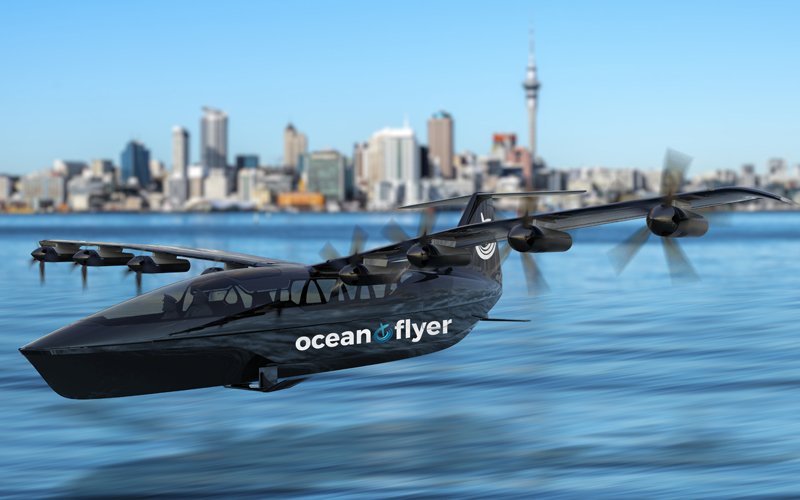
Photo: Ocean Flyer
A flight out of water
Ocean Flyer expects its electric seagliders to be on New Zealand waters by 2026.
The seaglider integrates five technologies to operate a few metres off the water’s surface.
“The concept’s technologies are not innovative or new of themselves, but it’s the way they are used together that creates the Ocean Flyer,” explains Operations Manager, John Hamilton CNZM, former Chief of Air Force in the Royal New Zealand Air Force.
The wing-in-ground effect, the hydrofoil, the use of carbon fibre structures, electric propulsion and battery capacity, and the use of automation are all crucial elements of this design. Manufactured by US-based Regent, the first manned prototype will be up and running by the end of the year.
“We’ve purchased 25 all-electric seagliders – 15 twelve-seaters and 10 one hundred-seaters – and aim to work with New Zealand engineers to design terminal buildings and pontoons as well as set up reticulated electricity and cabling to the water-based seagliders.”

Photo: MoMac
Challenge a “rite of passage for engineers”
The University of Canterbury Motorsport team has built a fully electric car which it hopes will break the land speed E1 record (under 500kg). The team of 16 engineering students aims to contest a 10-year standing record on salt flats in 2024.
The car, with 200kW motor, 12kWh battery pack and Formula 1 spec carbon fibre and kevlar monocoque, also has a parachute deployment system and on-board telemetry.
“It almost feels like a rite of passage for engineers to overcome a really ambitious challenge,” says Ben Robertson, Technical Director of the UC Motorsport Club’s Formula SAE car, and postgraduate electrical engineering student at the University.
“For us, this is quite daunting, but also something we can all fall in love with.”
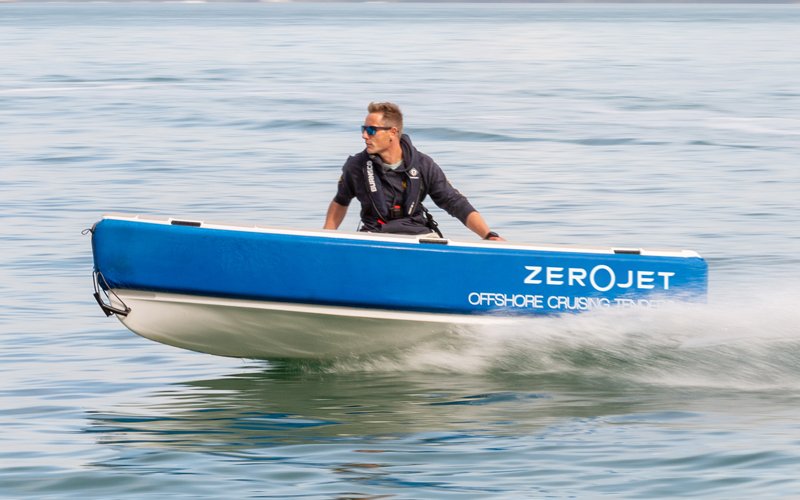
Photo: ZeroJet
Electric efficiencies
Kiwi engineering startup ZeroJet has been designing and manufacturing jet pumps powered by electric motors since 2015. Intending to eliminate combustion engines from small marine craft, the company continues to refine its jet system and electric motor to power it.
“For electric boats it all comes down to efficiency and that’s why our team of local engineers have developed our own high output 48-volt electric motor to match our in-house developed jet pumps,” says Neil Mans, director and co-founder of ZeroJet.
“Together with lithium ion phosphate batteries it puts us in a sweet spot, as it provides a whole system to replace combustion outboards for small boats.
“We have also devised a very innovative way of cooling our motor using a closed-loop cooling system, so we don’t need to pump saltwater through any of our electronics.”
Neil says: “All this bundled together allows us to offer a turn-key solution that’s easy for boat builders to work with.”
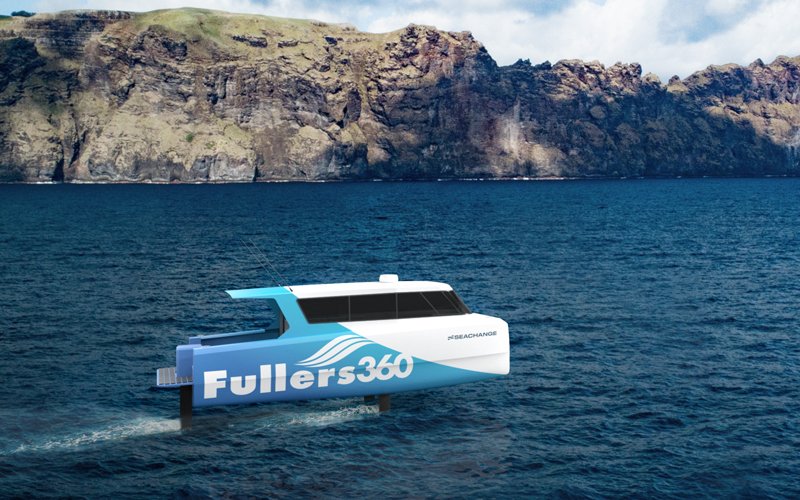
Photo: Seachange
On a larger scale, Seachange is developing electric foiling vessel technology aimed at decarbonising marine transportation. A 10-seater foiling electric boat is already in manufacturing stage for Fullers360 at Seachange’s facility in Mt Wellington, Auckland. The concept of foiling is not new, but its application to sustainability is. Foiling technology has the potential to viably replace numerous high speed vessels by significantly extending vessel range, increasing charge times and reducing operators’ expenses.
“The challenge for our engineers is in building a robust flying robot that has to be able to travel for thousands of miles in a 50cm altitude envelope. It is not trivial,” says Eric Laakmann, chief executive of Seachange and ex-Apple employee.
“The carrot though is large – through efficiency gains we can make vessels that can genuinely replace many vessels in high speed applications. Not only that but reduce fuel costs by 89 percent, which is the majority of most operators’ lifetime operating expenses.”
Fullers360 has taken the first order, with more than 10 other operators in New Zealand expressing interest so far. The first vessel is expected to be on the water this year and operating commercially by 2024.

Photo: Ohmio
Autonomous technology on track
Auckland-based Ohmio Automotion aims to address what it dubs the “first and last mile” for passengers – where public transport cannot go. Its electric autonomous Ohmio shuttle vehicle aims to shift passengers away from using private cars and make public transport more appealing, for example, when travelling from home to the bus depot or from the long-term car park to the airport terminal. And because much of New Zealand’s electricity generation is hydroelectric, the charging points are sustainable.
The technology creates customised autonomous vehicles that run on virtual tracks. With the motor and navigating system contained in the base of the vehicle, the shell can be configured to suit different needs.
Ohmio has demonstration vehicles heading to JFK International Airport in New York for a pilot scheme scheduled for June, where three Ohmio vehicles will work together in a platoon. The airport is looking to implement autonomous vehicles between parking lots and on-airport facilities.
“It’s the first and last mile and sometimes the only mile, where our vehicles come into their own,” says Mahmood Hikmet, Head of Research and Development for Ohmio Automotion, which had demonstration vehicles in Queenstown’s Beach Street earlier this year.


